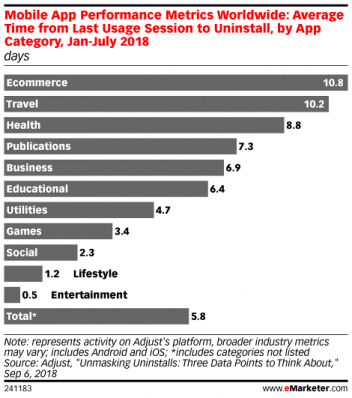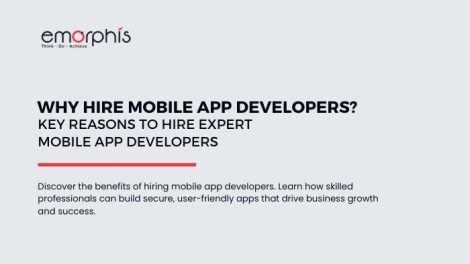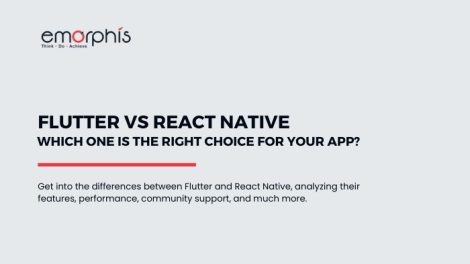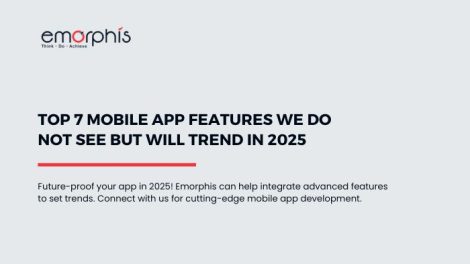Mobile app marketing involves interacting with customers throughout the lifecycle — from hearing about your app for the first time to becoming a loyal customer. To do this effectively, you need to figure out who will use your app, where to find those individuals and prospects, what to tell them, and what they want from you.
Today's mobile devices are pocketable supercomputers, and they become highly effective business tools when coupled with broadband networks and public cloud services. People are shifting progressively from the unconnected globe to the connected one. Around the world people are purchasing and adopting smart devices with superb pace, trying to alter their approach towards lifestyle – changing the way of entertaining, interacting, educating and shopping.
By the help of mobile app development agency, Companies are now mobilizing revenue generating streams and procedures. For instance, retail banking is shifting focus on digital-internet banking apps through smartphones and tablets. This move is continuous and is experienced in other industry sectors, where mobile apps empowered smartphones and tablets are evolving and replacing the personal computers and laptops.
Smart wearable-wrist band, boot has become a mainstream consumer and enterprise tool. "Data Snacking" is an individual’s capacity to interact with small bits of data, at regular interactions with relevant information on interested topics via smart wearables. This phenomenon will continue to advance as watchmakers cater for smaller wrists and high fashion standards. These devices will also begin to be used as part of multi-factor authentication systems.
The mobile app development sector is flourishing and ever-evolving year after year. We are seeing mobile app industry maturing in smartphones and tablets to wearable phones and the Internet of Things. Increased emphasis is now in place on app analytics and mobile app marketing.
Mobile app marketing activities should revolve around the three pillars of funnel – customer accretion (addition), customer incitement (motivation) and customer retention. The funnel idea is helpful, albeit customers often go back and forth between phases, so you can also hear this referred to as the "mobile engagement loop." In fact, each phase needs distinct approach and tactics, and each is needed for a successful marketing strategy for mobile apps.
Customer accretion stage explained
This is the first step where users relate with your app. The important question to be answered here is – How do you get them to download and install the app? Of course, the first part of building a cool app is getting people to use it. From a messaging opinion, you need to persuade a potential customer that your app can help solve a concern they have. The channels for sending these marketing messages are listed below:
- Social Networking Platforms: Undoubtedly, the most popular channel for app download and installation is social. And the most efficient channel is paid social advertising, in specific. An even more efficient channel is to get users of your app to hire their friends as customers once your app has momentum – something like a referral app.
- Incentivization: A popular approach is to offer a product giveaway, sweepstakes entry, or some other tangible reward in return for an app installation. One shortcoming of using real-world incentives is that users who sign up this way may end up immediately removing your app as soon as they receive their reward.
- Search Advertizing: Google Play and Apple's App Store both give in-store advertising that app executives can buy to drive downloads. Ads appear when customers search for app keywords — for instance, advertisements for mobile payment applications may appear when a user searches for "send money."
- Cross promotion: If you have more than one app, using one app to encourage another is a useful way to obtain customers. For instance, if your business generates a restaurant database, you can place advertisements in it that refer to your travel app, as consumers who are interested in one might be interested in the other.
- Listing on App Stores: App stores requires description - text and photo of each app. Writing listing is critical to convincing users to download it. Among other variables, the text in listing impacts whether consumers will see it as they look for applications in your category. Moreover, the reviews and ratings received also impacts the download rate.
In determining the right strategy, it’s important to keep track of Cost Per Acquisition (CPA). Channels like app store listing, or a web page, or organic social posts — is a zero-cost investment, although time consuming. Paid ads can be expensive, though are easier to optimize and scale. Comparative analysis between CPA and customers’ lifetime value determines the worthiness of time and cost investments. And the lifetime value calculation depends heavily on whether you can drive adoption, and then retain, the users acquired.
Customer incitement (motivation) –
Once the app is installed in the mobile, the next thing in mind of the marketer should be to keep the customer motivated to use the app. According to research study conducted by Adjust, which analyzed 8 billion app installed worldwide and found that apps gets uninstalled within 5 days from the day of installation, summing up within a week. Entertainment apps gets uninstalled in the quickest possible time, within a days’ time after last usage.

Image Source & Stats Credits to eMarketer
Thus, it becomes quintessential for the marketers to drive an adoption and motivation strategy, so that users are gelled to the app all the time. We list down below the mobile app channels for effective communication:
- Push notifications: Keep in your mind, to send push notification, may be one notification per day or in case of any important updates. It is very easy to brand push notifications, and one can even specify specific call to action with single tap.
- In-app messages: Like push notification, in-app messages are delivered to the user while they are using the app. One can place real time updates by tracking active users on the app.
- Messenger centre: The marketer can leverage passive channels inside the app, the dedicated place to look for important messages and notifications.
- Welcome messages: There are two approaches to the welcome message, after the first app installation, the marketer can send welcome messages on registration details viz. mobile number and email address. The second approach is to send welcome message when the user opens the app.
- Onboarding flow: This can be a short video showcasing how to use the app. This can increase engagement and trust. One can also brag about the salient features, and application benefits.
- Cross-channel marketing: These efforts are focused to send dedicated messages to mobile and email, again the end motive to engage and re-engage.
- Conversion Incentives: This is a subset to the incentivization discussed earlier, here certain coupon codes can be floated for instance to be used for online shopping on ecommerce site.
Customer retention –
Keeping your customers involved is a long-term proposition; retention is particularly crucial because it is a main factor in calculating a customer's lifetime value, and hence whether your attempts were profitable.
User retention is just as significant a factor in the achievement of your product as it informs you what element of your product engaged with your client and what makes them leave your product to another. Here we list down user retention strategies:
- Coupon codes for discounts: For products they are interested in, send users discounts or coupons. For retail, travel and local apps, these are the most productive. To get them back into the app, use your understanding of what the user expressed interest in before — perhaps even what's in their cart.
2. Specific content: Can you provide an exclusive guide for a sports app to build the ideal bracket, which is only accessible through the app?
3. Featured communication: Let users understand about your recent update or improvement and assist them to use it. For instance, if you just added the capacity to share playlists on Facebook from your music app, let users know.
4. Better Personalization: You've likely learned a lot about them once your customers have been using your app for a while. Can you use this understanding to make your app more useful? If you've just restarted your recommendation engine, for instance, send users a push notification inviting them to see their fresh options.
Summarizing it all
Whatever channel you use, user attention is a valuable resource, and make sure that what you send is valuable and relevant. Be sure to answer these questions whenever you send a message:
What is your message's objective? Is it worthwhile for your consumer?
When you receive it, what action do you want the customer to take? This will assist you more efficiently communicate your purpose and better assess its efficiency.
Where does message matter in context? All about context is mobile messaging: time, place, user preferences.
Will you take care of your customer? If you're a famous and a big popular, sending 20 push notifications a day might be okay. If you're not so big, you might not even need to send a weekly push notification because your user is casual that doesn't care about fresh characteristics.







